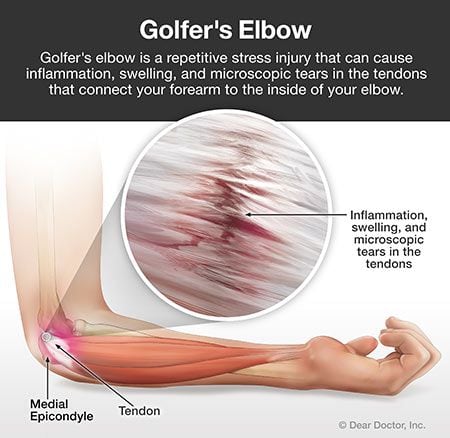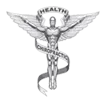Golfer’s elbow, or medial epicondylitis, is an overuse injury that can come about whether a person is a golfer or not. This condition causes pain in the elbow joint where the forearm connects to the elbow. Other symptoms associated with golfer’s elbow include stiffness, numbness, tingling, aching, a dull burn and weakness. Pain can increase when the wrist is moved in a forceful repetitive motion, and it may travel up the arm. This can limit the elbow’s range of motion and may make straightening the arm painful and difficult.
This condition, as well as tennis elbow, are forms of elbow tendonitis. The biggest difference between the two is that golfer’s elbow affects the tendons on the inside of the elbow while tennis elbow affects those on the outside of the elbow. While elbow tendonitis can negatively affect a person’s daily life, the good news is that chiropractic care can help alleviate the symptoms.
Causes of Golfer’s Elbow

Symptoms of golfer’s elbow tend to show up when a person repetitively uses his/her hands and fingers in a way that strains or overworks the forearm muscles (especially those connected to the elbow). This is usually from gripping, flexing or swinging repetitively for months to years. As a result of the strain, pulls or tiny tears can occur in the tendons, and scar tissue begins to form. The development of scar tissue in the elbow causes pain where the forearm tendons connect to the elbow bone.
Activities commonly known to cause this condition include golfing, baseball, rock climbing, texting, typing, playing video games, archery, using a hammer, playing football and javelin throwing. If left untreated, golfer’s elbow can develop into a chronic condition that will likely require more intensive, expensive and time-consuming health care.
Treatment for Golfer’s Elbow
Chiropractic care typically uses a variety of approaches when treating the symptoms of golfer’s elbow. These techniques are designed to break up the scar tissue surrounding the elbow, reduce any inflammation in the elbow, and return the normal range of function to the elbow joint and forearm muscles. Treatment methods include spinal manipulation, myofascial release and active release techniques, massage, fascial stripping, stretching exercises for the forearm flexors and pectoral muscles, eccentric exercise therapy (challenging a muscle by slowing down the elongation of the muscle, such as when lowering a heavy object slowly), and Kinesio tape.
Why Seek Chiropractic Treatment for Golfer’s Elbow?
Since this condition can become chronic if left untreated, it’s important to correct any issues in the elbow as soon as the symptoms arise. If elbow tendonitis is suspected, we will examine your elbow, wrist and cervical spine in an effort to eliminate added stressors that may be contributing to the pain. Upon pinpointing the cause of your pain, we can recommend a treatment plan based on your unique set of symptoms and daily activities. Keep in mind that chronic conditions left untreated for years may require more time and attention. The sooner you seek treatment for golfer’s elbow, the better your chances are of regaining a full range of motion and avoiding long-term difficulties with moving your arm.
